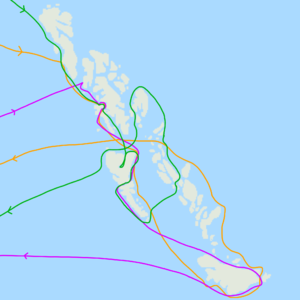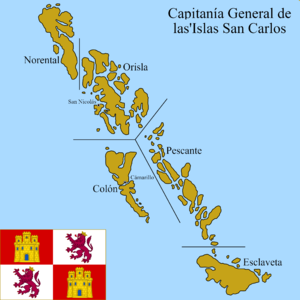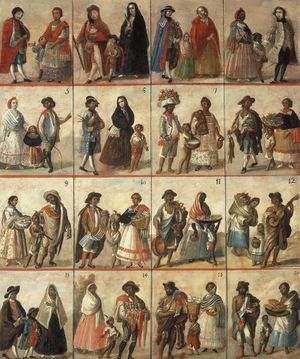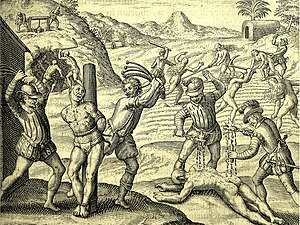Difference between revisions of "Captaincy General of the San Carlos Islands"
| Line 147: | Line 147: | ||
}} | }} | ||
| − | The '''Captaincy General of the San Carlos Islands''' ([[Creeperian Spanish]]: ''Capitanía General de las'Islas San Carlos'' pronounced {{color|blue|/ˈka.piˈtan.ia ˈxen.eɾˈal de lasˈis.las ˈsan ˈkar.los/}}), also referred to as the '''Creeperian San Carlos Islands''' or simply the '''San Carlos Islands''', or sometimes referred to as by the Spanish '''Islas San Carlos''', was a colony and administrative division of the [[Creeperopolis|Kingdom of Creeperopolis]]. From 1381 until 1387, Admiral [[Cristóbal Colón Cámarillo]] of the [[Creeperian Navy]] [[Voyages of Cristóbal Colón Cámarillo|traveled to and explored]] the islands and established a Creeperian colonial presence on the archipelago which he named the ''San Carlos Islands''. | + | The '''Captaincy General of the San Carlos Islands''' ([[Creeperian Spanish]]: ''Capitanía General de las'Islas San Carlos'', pronounced in Creeperian Spanish: {{color|blue|/ˈka.piˈtan.ia ˈxen.eɾˈal de lasˈis.las ˈsan ˈkar.los/}}), also referred to as the '''Creeperian San Carlos Islands''' or simply the '''San Carlos Islands''', or sometimes referred to as by the Spanish '''Islas San Carlos''', was a colony and administrative division of the [[Creeperopolis|Kingdom of Creeperopolis]]. From 1381 until 1387, Admiral [[Cristóbal Colón Cámarillo]] of the [[Creeperian Navy]] [[Voyages of Cristóbal Colón Cámarillo|traveled to and explored]] the islands and established a Creeperian colonial presence on the archipelago which he named the ''San Carlos Islands''. |
Colón Cámarillo was appointed as the islands' first [[Capitan General of the San Carlos Islands|Captain General]] in 1387 and he ruled until his death in 1392, from which, the military ruled the islands mostly unchecked. [[Pedro Gutiérrez Valdivia]], Colón Cámarillo's immediate successor, increased his use usage of slavery, turning the southernmost island of the archipelago into a slave trading hub where most of the islands' slaves originated from. In 1565, the islands experienced the Parliamentization where the islands transitioned from military rule to civilian rule with democracy and a parliament. | Colón Cámarillo was appointed as the islands' first [[Capitan General of the San Carlos Islands|Captain General]] in 1387 and he ruled until his death in 1392, from which, the military ruled the islands mostly unchecked. [[Pedro Gutiérrez Valdivia]], Colón Cámarillo's immediate successor, increased his use usage of slavery, turning the southernmost island of the archipelago into a slave trading hub where most of the islands' slaves originated from. In 1565, the islands experienced the Parliamentization where the islands transitioned from military rule to civilian rule with democracy and a parliament. | ||
Revision as of 05:34, 3 January 2021
Captaincy General of the San Carlos Islands Capitanía General de las'Islas San Carlos | |||||||
|---|---|---|---|---|---|---|---|
Motto: Viva y Salve las'Islas San Carlos | |||||||
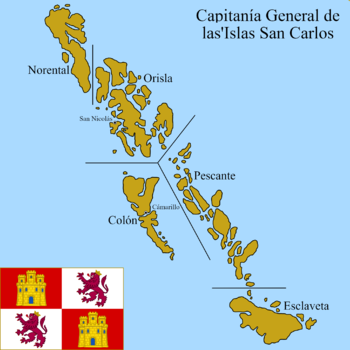 | |||||||
| Status | Creeperian colony | ||||||
| Capital | Cámarillo | ||||||
| Common languages | Creeperian Spanish | ||||||
| Religion | Creeperian Catholic Church | ||||||
| Demonym(s) | San Carlositos | ||||||
| Government | Captaincy General | ||||||
| King | |||||||
• 1387–1405 | Miguel II | ||||||
• 1500–1555 | Miguel V | ||||||
• 1555–1587 | Alfonso III | ||||||
• 1634–1666 | Alfonso IV | ||||||
• 1730–1749 | Adolfo II | ||||||
| Captain General | |||||||
• 1387–1392 | Cristóbal Colón Cámarillo | ||||||
• 1565–1580 | Antonio Mendoza Pacheco | ||||||
• 1685–1736 | Juan Palafox Mendoza | ||||||
• 1745–1749 | Luís Enríquez Guzmán | ||||||
| Legislature | Parliament | ||||||
| Chamber of Representatives | |||||||
| Chamber of Islanders | |||||||
| Historical era | Colonial | ||||||
• Proclaimed | 1 June 1387 | ||||||
• De facto established | 15 September 1387 | ||||||
• Parliamentization | 1 March 1565 | ||||||
• Sold to Xusma | 13 October 1749 | ||||||
| Population | |||||||
• 1387 | 223,584 | ||||||
• 1749 | 957,715 | ||||||
| Currency | Creeperian Peso | ||||||
| |||||||
| Today part of | |||||||
The Captaincy General of the San Carlos Islands (Creeperian Spanish: Capitanía General de las'Islas San Carlos, pronounced in Creeperian Spanish: /ˈka.piˈtan.ia ˈxen.eɾˈal de lasˈis.las ˈsan ˈkar.los/), also referred to as the Creeperian San Carlos Islands or simply the San Carlos Islands, or sometimes referred to as by the Spanish Islas San Carlos, was a colony and administrative division of the Kingdom of Creeperopolis. From 1381 until 1387, Admiral Cristóbal Colón Cámarillo of the Creeperian Navy traveled to and explored the islands and established a Creeperian colonial presence on the archipelago which he named the San Carlos Islands.
Colón Cámarillo was appointed as the islands' first Captain General in 1387 and he ruled until his death in 1392, from which, the military ruled the islands mostly unchecked. Pedro Gutiérrez Valdivia, Colón Cámarillo's immediate successor, increased his use usage of slavery, turning the southernmost island of the archipelago into a slave trading hub where most of the islands' slaves originated from. In 1565, the islands experienced the Parliamentization where the islands transitioned from military rule to civilian rule with democracy and a parliament.
The captaincy general remained as a parliamentary democracy from 1565 until 1749, then the archipelago was sold to Xusma in a purchase now known as the Guazatancillo Affair for 15 million credits, worth around 2.6 billion credits adjusted to inflation. The purchase was agreed upon by Creeperian Prime Minister Orlando Moreno Hidalgo and Xussman Tsar Pyanykh I, where the archipelago was renamed to the Southwestern Territories Colony of Khalkovo. Creeperian influence on the islands persisted as many names given by the Creeperans remain today, either fully intact or translated into Xussman, such as Admiralia, Camarillo, and the name of the country itself.
The Captaincy General of the San Carlos Islands was the first overseas Creeperian colony that composed the so-called Creeperian Colonial Empire. It was also the longest lasting Creeperian colony, existing for 362 years from 1387 to 1749. The Creeperans colonized the islands longer than the Xussmans, who controlled the islands for 192 years from 1749 to 1941. From 1811 to 1834, the Creeperans attempted to recapture the islands from the Xussmans during the Khalkovo War, creating the Principality of the San Carlos Islands with Porfirio Mendoza Basadone, a member of the influential Mendoza Family, as Prince of the San Carlos Islands.
The captaincy general consisted of five viceroyalties: Colón, Esclaveta, Norental, Orisal, Pescante. The Captaincy General covered the present-day nation of the San Carlos Islands, which became independent from Xusma in 1941. The captaincy general was one of the three overseas colonies controlled by Creeperopolis, with the other two being the Principality of the San Carlos Islands from 1811 to 1834 and the Second Lyoan Empire from 1797 to 1837.
Several atrocities are recorded to have occurred during Creeperian rule of the San Carlos Islands, including mass murder, ethnocide, and genocide against the Natives of the islands, particularly during the early military period from 1392 to 1477, commonly known as "The Enslavement."
Contents
- 1 Background
- 2 History
- 3 Geography
- 4 Political organization
- 5 Demographics
- 6 Culture and art
- 7 See also
Background

In the early 1300s, Quebecshirite Captain Félix Vernier encountered a group of islands southwest of New Gandor and named them Gandeur du Sud, translated as South Gandor. Vernier never stepped foot on the islands but their location was documented.
Meanwhile, the Creeperian Crusade concluded in 1345 in Creeperopolis with the fall of Shata' Albahr. King Miguel I died in 1365 and was succeeded by his son, Adolfo I, who was made aware of the islands' existence and he wanted to conquer new lands like his father had done. Internal economic issues prevented the Creeperans from sending an expeditionary force to the islands during the 1360s and 1370s, but in 1380, the Creeperian Navy was able to gather enough money, support, and resources to fund a voyage to the islands.
The voyage east was lead by Admiral Cristóbal Colón Cámarillo and composed of three ships: the Rey Alfonso I, the Rey Felipe I, and the Rey Machtītin I. The ships left the port of Salvador on 18 April 1381 and headed east across the Southern Ocean. On 12 October 1381, Colón Cámarillo landed on the largest island in the north of the archipelago which he called La'Isla Gran del Admiral, later known as simply Admiralia, the island's current name. The Creeperans met with some Natives of the island and they were introduced to their village. The two exchanged gifts; the Creeperans gifted the Natives hammocks and crosses while the Natives gifted the Creeperans beads, candles, whale bone tools, and gold. After a few days, the Creeperans departed, believing that the island was rich in gold. As the ships departed, Colón Cámarillo named the islands Los'Islas Imperiales de San Carlos el Mártir de Creeperopólis, translated as The Imperial Islands of San Carlos the Martyr of Creeperopolis, named after Saint Carlos, the youngest son of Alfonso I who died in combat in 1299. One of his patronages was gold, and since the Creeperans were gifted gold by the Natives, the islands were named after Saint Carlos. The name would eventually be shorted over time to simply the San Carlos Islands.
The Creeperans then headed south and explored more of the islands of the archipelago, naming all of the ones they came across. They landed on the island of Chirikov and established their own settlement called of Saint Nicholas. The Creeperans worked with the Natives there and were able to live off of food provided by the Natives. Creeperian Catholic priests taught the Natives Creeperian Spanish in order to better communicate with the Natives and many were even converted to Catholicism. The Creeperans traveled north along the eastern coast of the archipelago. The Creeperans then returned to Creeperopolis and arrived to Salvador on 18 March 1382. Colón Cámarillo showed Adolfo I the gold they were gifted and he immediately began preparations for a second voyage to begin finding good locations to make permanent settlements.
On 17 November 1383, Colón Cámarillo commanded the same three ships and traveled to the San Carlos Islands with the mission of finding locations that would be perfect to establishing permanent settlements. The Creeperans carried coffee with them this time as gifts for the Natives and as bribes so that they would be willing to live under Creeperian rule. Colón Cámarillo and his fleet landed on the island just south of Admiralia on 15 March 1834. They established a temporary settlement and continued to San Nicolás a week later. They arrived on 26 March 1834 and reunited themselves with the Natives still living there. Colón Cámarillo established a permanent settlement at San Nicolás. They stayed there for two months, improving relations with the natives, trading goods, and building up the settlement. Of the 1,200 men on the journey, 400 stayed behind to maintain the settlement and continue relations with the Natives. Colón Cámarillo placed Pedro Gutiérrez Valdivia, his second-in-command, in charge of San Nicolás and the Creeperans departed on 13 June 1384. They sailed south, following the same route as the first voyage, and again sailed along the coast of the island of Cámarillo. Colón Cámarillo continued to follow the coast and encountered a large Native settlement on the island on 24 June 1384. The settlement was home to 30,000 Natives and both had a friendly initial interaction. Both groups traded gifts and the Creeperans settled there for three months. They were treated as guests and the Creeperans helped the Natives develop the settlement. Colón Cámarillo named the settlement Ciudad Grande del Admiral Cristóbal Colón Cámarillo, after himself. The city is know known as simply Camarillo with the "á" replaced with an "a" after the Creeperans left the islands. The Creeperans departed the city on 1 September 1384 and carefully charted down its location since Colón Cámarillo wanted to make the settlement the islands' capital city. The Creeperans headed west and then south, and then returned to Creeperopolis, arriving in Salvador on 13 February 1385.
When he returned, he arrived to a country fighting another war against the Deltinians. While he was gone, in 1384, the Deltinians, under the leadership of Caliph Orhan III bin Abu Zaidi, revolted against Adolfo I in the departments of Abdan, Helam, and Jakiz. As a result, plans for a third voyage were put on hold, but plans were made nonetheless.Adolfo I died on 2 May 1385 and was succeeded by his son, Miguel II. Under Miguel II, the Deltinian rebellion was mostly crushed with some holdouts in Abdan that would be fully defeated in 1403. In 1387, Miguel II authorized the third voyage to officially claim the San Carlos Islands as a colony of Creeperopolis.
History
Under Colón Cámarillo (1387–1392)
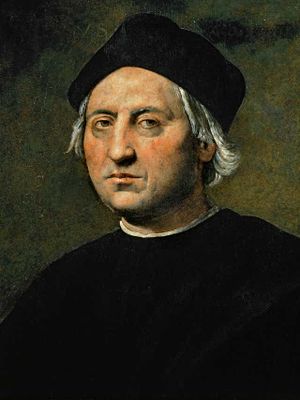
On 1 June 1387, Miguel II proclaimed the establishment of the Captaincy General of the San Carlos Islands to govern the San Carlos Islands in representation of the monarchy. He proclaimed Colón Cámarillo as the Capitan General of the Captaincy General and he began his final voyage to the San Carlos Islands. He would never see Creeperopolis again. The same three ships were taken, but six additional ships were also carrying hundreds of Creeperian families to settle the islands. Around 4,500 Creeperian men, women, and children were aboard the nine ships.
Colón Cámarillo's fleet arrived at the northernmost tip of Admiralia and continued south until they reached San Nicolás. There, 1,000 of the settlers departed and permanently settled in San Nicolás. Colón Cámarillo replaced Gutiérrez Valdivia with Francisco Villagra Velázquez as being in charge of San Nicolás and appointed him as Mayor, the first Creeperian Mayor in the San Carlos Islands. Colón Cámarillo and Gutiérrez Valdivia took seven of the nine ships to Cámarillo where 3,500 more settlers permenently stayed. Colón Cámarillo appointed Gutiérrez Valdivia as Mayor of Cámarillo and made it the capital city of the Captaincy General on 15 September 1387. The name of the city was also officially changed to Cámarillo. One ship with 500 men commanded by Diego Kassandro Moreno was sent to continue exploring the archipelago and continue mapping the area and return to Creeperopolis. The ship continued to navigate the archipelago and returned to Salvador on 3 February 1388, ending the three voyages of Colón Cámarillo. On 4 October 1388, Colón Cámarillo ordered the enslavement of all adult male Natives on the island of Esclaveta, modern-day Zolotka. He expressed that he would only enslave adult men from the island and strictly forbade the enslavement of women, children, and the elderly. He stated that he wanted to "punish those who hurt us, not those who have done nothing to us."
Colón Cámarillo expanded the city of Cámarillo during his tenure as Captain General of the San Carlos Islands, growing it from a small village to a proper city, the largest on the island. Creeperian settlers and Natives coexisted in the city and actively traded with each other. Colón Cámarillo even appointed several Natives to administrative jobs in Cámarillo and across the archipelago. In 1392, the Creeperian Catholic Church permitted interracial marriages between Creeperans and Natives, producing the first children of a mixed race on the island.
The Enslavement (1392–1477)
- Top left: Pedro Gutiérrez Valdivia (1392–1412)
- Top right: Gustavo Hurtado Mendoza (1412–1427)
- Bottom left: Miguel Quiroga López (1427–1463)
- Bottom right: Melchor Bravo Saravia (1463–1477)
Colón Cámarillo died on 22 April 1392 and was succeeded as Captain General by Gutiérrez Valdivia, his second-in-command who he had appointed as Mayor of Cámarillo. Although Colón Cámarillo officially retired from military life when he assumed command as Captain General, Gutiérrez Valdivia remained on active military duty and continued to command soldiers in battle.
Under Gutiérrez Valdivia, all Natives were expelled from administrative positions, undoing the work of Colón Cámarillo. He also increased commitment to subjugating and enslaving Esclaveta, earning him the nickname "El Esclavizador," meaning "The Enslaver." During his tenure, brutal punishments were introduced against slaves who violated laws or codes of conduct, including torture and death. A caste system, known as the Casta, was also introduced as a form of segregation and established a racial hierarchy. The period has become known as "The Enslavement" and is considered the worst period of Creeperian rule in the San Carlos Islands.
In 1402, Gutiérrez Valdivia ordered the construction of two Creeperian Catholic missions on the archipelago: the San Carlos Mission in Cámarillo and the San Nicolás Mission in San Nicolás. Both missions were completed and consecrated by the Church in 1411. Both missions were constructed by Native slaves overseen by Creeperian supervisors. Of the missions, San Nicolás is still in active use today, while San Carlos was destroyed during the Khalkovo War with Xusma in 1811. Both were listed as Creeperopolis National Historical Landmarks on 8 June 1970.
Gutiérrez Valdivia was assassinated on 3 May 1412 by one of his Native slaves in the National Palace in Cámarillo. He was shot in the back of the head by the slave who stole a gun from a guard. Gutiérrez Valdivia was succeeded by Gustavo Hurtado Mendoza, the Mayor of Cámarillo, who had the slave publicly tortured to death in front of the National Palace. The slave's entire family was also put to death due to their relation to him. News of the assassination spread across the islands, and when it reached Esclaveta, the slaves staged an uprising against the Creeperans. The revolt was crushed by the end of the year by Hurtado Mendoza's forces. He was the first member of the later to be very influential Mendoza Family to serve as Captain General of the San Carlos Islands. Hurtado Mendoza had two large statues of Colón Cámarillo and Gutiérrez Valdivia constructed in front of the San Carlos Mission in 1417 in their memory for what they have contributed to the islands. Neither statue stands today as they were both destroyed in 1811.
The Orisal gold mine was established in 1387 by Colón Cámarillo and had been manned by slaves since 1389, but since then, the mine had begun to run into financial issues as less and less gold was being discovered. In 1419, Hurtado Mendoza opened a new mine new mine 3 miles south of the old mine, officially abandoning the old mine in 1421 after two months without finding any gold. The mine was later blown shut in 1749 by Creeperian landowners who wanted to prevent the Xussmans from using it in the future. The new mine was excavated and mined by Native slaves, with regimes being extremely rough and difficult at 12-hour work days every day of the week. Most of the gold mined went directly to Creeperopolis, while the remainder of the gold went into the San Carlos Islander economy or foreign buyers.
The Liberation (1477–1565)
Parliamentization (1565–1580)
Conservative governance (1580–1645)
Liberal governance (1645–1685)
Tenure of Palafox Mendoza (1685–1736)
Late period (1736–1749)
The Guazatancillo Affair
Geography
Political organization
Legislature
Executive
Judiciary
Administrative divisions
Viceroyalties
| Flag | Viceroyalty | Capital | Largest City | Established | Population (1749) |
|---|---|---|---|---|---|
| Colón | Cámarillo | Cámarillo | 24 June 1384 | 375,188 | |
| Esclaveta | Anadesa | Anadesa | 4 October 1388 | 64,582 | |
| Norental | Arcángel | Arcángel | 12 October 1381 | 142,487 | |
| Orisal | San Nicolás | San Nicolás | 16 November 1381 | 234,184 | |
| Pescante | Cena | Cena | 30 January 1391 | 135,274 | |
| Islas San Carlos | Cámarillo | Cámarillo | 1 June 1388 | 957,715 |
Municipalities
Demographics
Caste system
Under Gutiérrez Valdivia, a caste system was established to separate the population of the captaincy general by race and ethnicity. It was is effect from 1400 until it was abolished in 1565. The caste system was called the Casta and it was composed of sixteen castes. The castes were:
- Creeperian with Native, Natizo
- Natizo with Creeperian, Cartizo
- Cartizo with Creeperian, Creeperian
- Creeperian with Deltinian, Delato
- Delato with Creeperian, Delo
- Delo with Creeperian, Chino
- Chino with Native, Detizo
- Detizo with Delato, Deltato
- Deltato with Chino, Jíbaro
- Jíbaro with Delato, Albarazado
- Albarazado with Deltinian, Cambujo
- Cambujo with Native, Zambiaga
- Zambiaga with Deltato, Calpamulato
- Calpamulto with Cambuja, Morisca
- Morisca with Delato, Delisca
- Delisca with Native, Detiva
Religion
The official and main religion of Creeperopolis was Creeperian Catholicism under the theology and doctrine of the Creeperian Catholic Church. The Church is lead by the Pope, and during the captaincy general, the Papacy approved of the conversion of the Natives of the archipelago. Most of the archipelago's Natives were converted to Creeperian Catholicism, either willingly or through force. The practicing of the religion was a requirement for government benefits, and refusing to convert was faced with punishments of forced labor, torture, exile, or death.
On 12 October 1390, Pope Boniface IX established the Archdiocese of the San Carlos Islands and consecrated Pedro Moya Contreras as its first archbishop. Although most San Carlos Islanders converted to Xussman Orthodoxy following the archipelago's transition to Xussman control in 1749, a significant minority of Creeperian Catholic remain in the country.
Three saints were canonized by the Creeperian Catholic Church that were born in the San Carlos Islands during the captaincy general. Those saints include:
- Miguel Zumárraga Arrazola (1533–1593), Archbishop of the San Carlos Islands (1574–1593)
- Diego Cosnvarubias Torres (1542–1602), witnessed four apparitions of Our Lady of Cámarillo in 1575
- Juan Palafox Mendoza (1652–1736), Archbishop of the San Carlos Islands (1682–1736), Captain General of the San Carlos Islands (1685–1736)
Use of slavery
During Colón Cámarillo's second voyage, he and his crew landed on the island of Zolotka. During their time there, they settled near a Native settlement of 200 people. On 4 October 1385, a fight erupted between the Creeperans and the Natives. The reason for the fight is unknown, but it is speculated to have been over the Creeperian settlement or the Creeperian use of the land while they were settled there. During the fight, eight people were killed, with four deaths on both sides. Around thirty others were injured in the fight. The Natives demanded that the Creeperans never return to the island, and the Creeperans left for Salvador the next day.
Colón Cámarillo did not forget about the fight when he returned to the San Carlos Islands to serve as its Captain General. On 4 October 1388, exactly three years after the fight, he ordered the enslavement of all adult male the Natives on the island where the fight occurred. In the declaration, he established the viceroyalty of Esclaveta, meaning "Land of Slavery." He strictly forbade enslavement of women, children, and the elderly. He stated that he wanted to "punish those who hurt us, not those who have done nothing to us."
In November 1388, he commanded a fleet of four ships with 800 men to subjugate the island and enslave the people. The fleet landed on 14 December 1388, roughly near where the fight occurred three years earlier. They found the Natives that had attacked them and moved to capture them. The Natives fought back, but the Creeperans managed to capture most of the Natives, with the remainder fleeing or being killed. Any women, children, and elderly captered were released. The event began the Esclaveta War which lasted until 1401 where the Creeperans launched attacks against the Natives to subjugate them into slavery and the Natives launched attacks on the Creeperans to maintain their freedom. The struggle was in vain, however, and most of the Native population was enslaved, with the remainder somehow fleeing north to other islands or dying during the struggle for freedom.
When Colón Cámarillo was captain general, bloodshed was not very common, with light skirmishes and scarce engagements being the norm. When Gutiérrez Valdivia became captain general, however, violence and battles became commonplace, with many massacres being committed by Creeperian soldiers against Native warriors and even Native women and children and elderly who were noncombatants, against the wishes of Colón Cámarillo. The massacres committed under Gutiérrez Valdivia from 1392 until the war's end in 1401 are known as the Esclaveta Genocide, where 6,000 Natives died out of a total populaiton of 19,000 people, approximately 32% of the population.
During Gutiérrez Valdivia's tenure as captain general, the Natives of Esclaveta were forced to work on plantations, in mines, and at construction sites across the captaincy general. Men and teenage boys were the ones sent to the mines and construction sites, while women, girls, the elderly, and younger boys were sent to plantations, ignoring what Colón Cámarillo had strictly stated. Around 30% of the population remained on Esclaveta to repopulate and continue "producing fresh slaves" for the captaincy general.
There were specific punishments handed down to slaves for committing certain acts. Escaping, attempting an escape, murder, attempted murder, and rape were punished by death. Refusing to work, robbery/theft, and other miscellaneous crimes were punished by torture. Methods of torture included whipping, flogging, burning, and other methods of torture.
The rule of Gutiérrez Valdivia is considered the darkest period in San Carlos Islander history. In total, around 30,000 to 50,000 Natives died during his tenure from 1392 to 1412. Palafox Mendoza later remarked in 1692 that "[Gutiérrez Valdivia's] tenure of twenty years was the worst twenty years in the history of this small archipelago in the [Southern] Ocean." The early military rule from 1392 through 1477 is commonly referred to as "The Enslavement" due to the brutality of the captain generals. Gutiérrez Valdivia's successors, Hurtado Mendoza (1412–1427), Quiroga López (1427–1463), and Bravo Saravia (1463–1477), all continued his legacy and policies of anti-Nativism and brutality.
Several slave revolts occurred when slavery was legal. The first occurred in 1412 against Hurtado Mendoza after Gutiérrez Valdivia was assassinated by a slave in Cámarillo. The revolt was crushed by the end of the year.
Culture and art
Regional anthem
| Creeperian Spanish lyrics | Lyoan Translation | Xussman Translation |
|---|---|---|
CORO
ESTROFA
CHORO
|
CHORUS
VERSE
CHORUS
|
ХОР
СТИХ
ХОР
|


